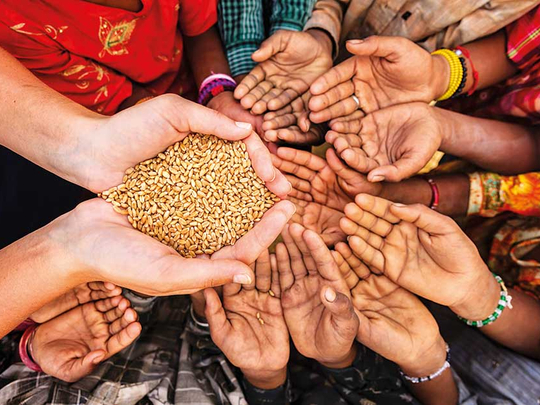
New York City. 2022. The Big Apple is packed — with 44 million inhabitants — and roasting. Average temperatures are in excess of 30°C.
The metropolis is enveloped in a thick, greyish fog. Water is scarce.
Fauna and flora have almost disappeared.
Food produced from agriculture is a distant memory, alive only in the minds of the older generations.
Only a few rich, privileged people have access to fruit, meat, strawberry jam or bourbon.
The vast majority has long been eating synthetic food produced by the multinational corporation Soylent.
These are small square tablets of different colours, depending on the day of delivery.
That year, a new one joins the collection: Soylent Green, more nutritive, but also more expensive and delivered on Tuesdays only.
That’s when one of the company’s board members, William Simonson, is killed at his home, in one of the tower blocks in a wealthy neighbourhood.
Police officer Thorn leads the investigation and eventually finds out the horrible truth: Soylent Green isn’t made with “high-energy plankton,” as the company claims, but with human corpses!
Anthropophagy has entered the human food system. And because he wanted to reveal the truth, William Simonson was assassinated.
This short synopsis of Richard Fleischer’s 1973 science-fiction movie Soylent Green, with Charlton Heston playing Thorn, expresses in an apocalyptic fashion the dread of an over-exploited planet and an alimentary future threatened by overpopulation and resource scarcity.
History of the fear of global starvation
This anxiety resurfaces today as famine affects Niger, Ethiopia and, even more severely, South Sudan.
The fear of global starvation, however, is much more ancient. Malthus first sparked the debate in 1798.
ALSO READ:
World population seen up to 9.7b in 2050: study
The population bomb is ticking
Where is the world’s densest city?
Solving the world’s growing population issue
10 most populated countries in the world
How surging population hurts hard-won gains
The English economist reckoned that population was rising faster than resources, so he concluded that inevitably, demographic catastrophes would unfold unless population growth was restricted.
His forecasts didn’t materialise. Higher agricultural yields and new international means kept pushing the presumed breaking point back.
Room for growth
Richard Fleischer’s fears didn’t materialise either. Or at least not yet.
When the film was released in 1973, there were just 3.8 billion people living on our planet.
In 2017, the world population already stands at 7.3 billion.
And the number will keep on rising. The UN believes we’ll reach 9.7 billion people in 2050 and a little over 11 billion by the end of the century.
Fleischer’s ghosts might then resurface on a planet where resources (arable land, pastures for livestock, fish stocks) are finite.
Though it’s been decreasing for several decades, malnutrition is still striking populations.
According to the World Bank’s World Development Report 2017, 11 per cent of the world population suffers from malnutrition. For poor countries, the figure rises to 25 per cent.
Gael Giraud, chief economist at the French Development Agency, says that “on the sole question of our capability to feed 9 billion people in 2050, our planet has the physical resources to do it.”
Unused land
Rabah Arezki, an economist at the International Monetary Fund (IMF), agrees, as does the Organisation for Economic Cooperation and Development (OECD).
“Putting all unused land into service, assuming everything else remains equal, would help feed 9 billion people,” Arezki argued in a study published last October for the IMF’s World Economic Outlook.
Globally, about 20 per cent of the land is still uncultivated.
The figure rises to over 40 per cent in sub-Saharan Africa and South America, according to the IMF.
This means that there is potential for an increase of food production, particularly in sub-Saharan Africa, where yields are 50 per cent below their potential level, the IMF says.
Take corn for example. For the sake of comparative analysis, researchers use the coefficient 1 to measure the yield in the United States, the world’s leading corn producer.
The yield in sub-Saharan Africa, by contrast, is 0.19. And in Asia and Latin America, it is 0.48 and 0.43 respectively.
The numbers are similar for rice production, with Oceania as the reference point.
Our dear planet Earth, in other words, still has reserves.
“Killer” trade practices
So why do millions of people still suffer - and sometimes die - from hunger?
In Niger, more than 1.3 million people (7 per cent of the total population) are in urgent need of food assistance in the next fourth months even though the country had cereal surpluses last year, the UN said in mid-May.
In a report it published in March, the Food Security Information Network observed that, “globally, 108 million people in 2016 were reported to be facing crisis level food insecurity or worse. This represents a 35 per cent increase compared to 2015 when the figure was almost 80 million.”
The Indian economist Amartya Sen, who won the Nobel Prize in 1998, was the first to warn, as early as 1981, that hunger wasn’t necessarily due to a lack of food but rather to a lack of means to buy that food.
“It’s the inequality of our trade practices that kills,” Gael Giraud confirms.
Both the IMF and the OECD denounce the harmful effects of agricultural policies of different countries, done in the name of their "food sovereignty" and of the protection of their farmers.
Negotiations blocked
It’s actually one of the reasons why trade negotiations at the World Trade Organisation have been blocked for 15 years.
Direct or indirect subsidies to farmers distort free trade and, as a result, hinder efficient food distribution.
This is particularly striking for soybeans, sugar, rice, wheat, beef, pork and poultry, according to the IMF.
Statistically, 85 per cent of food is consumed where it is produced.
And agricultural products represent just 8% of international trade.
But the quick urbanisation and galloping growth of African and Asian countries make them dependent on imports.
Since 1990, 24 countries (nine from sub-Saharan African, seven from Southeast Asia and the Pacific, and eight from Latin America) have gone from being net exporters to net importers.
It is thus crucial to remove these trade barriers, as emerging economies are rising to power.
The spawning of wealthier middle classes goes hand in hand with new eating habits.
“Income growth reorients the composition of demand, for instance, toward meat, dairy, vegetables and fresh fruit,” writes Rabah Arezki.
“Chinese consumers have moved away from staples (such as grains and rice) toward a more diversified and higher-quality diet.”
In a recent research paper, Christophe Gouel and Houssein Giumbard of the French research institute Cepii predict an increase in caloric demand of 46 per cent by 2050, with a 95 per cent increase in demand for animal-based calories.
The International Food Policy Research Institute, meanwhile, believes that population growth will require a 70 per cent increase in caloric production.
What the world is witnessing is no less than a transformation of eating habits.
Rising temperatures
Removing trade barriers alone, however, won’t suffice to cover Asia and Africa’s needs, with both continents forecast to have 1.3 billion and 875 million more people to feed, respectively, in 2050.
Improvements in land productivity is more than ever a decisive factor, but the dosage must be subtle to protect biodiversity and ecosystems, and avoid increasing carbon emissions too much, the IMF warns.
In the middle term, the main challenge will be dealing with the effects of climate change.
“The impact from climate imbalance will be very unequally spread,” says Gael Giraud.
“Our simulations indicate that it will soon be too late to be able to keep the global average temperature’s rise below 2 degree C at the end of the century.
+3C in Africa
This means at least + 3 degree C for the African continent and therefore, very likely, a fall in agricultural productivity.”
The countries closest to the equator are the most vulnerable.
Last year, Ethiopia experienced one of its worst drought episodes in the last decade, and the country relies on the two rainy seasons to obtain 80 per cent of its agricultural production — a sector that employs 85 per cent of the population.
“Such extreme events will get worse and take place more frequently,” Giraud says.
And Africa will be the first to suffer, along with some regions across Asia and Latin America.
But without close international cooperation, there certainly is a risk that the planet will experience more episodes of famine and potentially violent conflict.
Who knows? The future may even prove Richard Fleischer right, in the more or less long run.
–Worldcrunch/New York Times News Service














